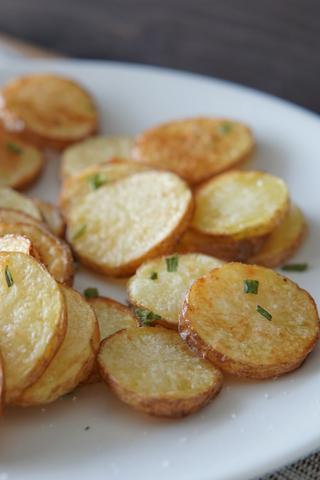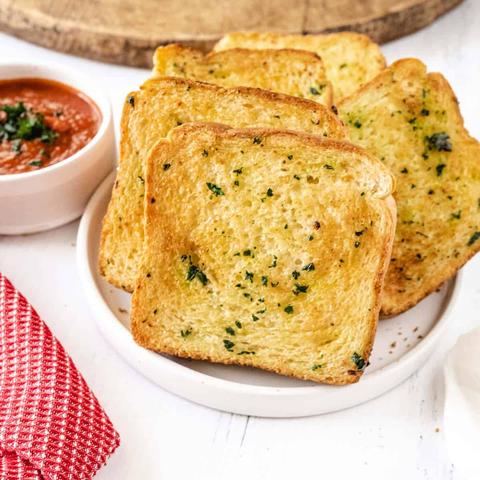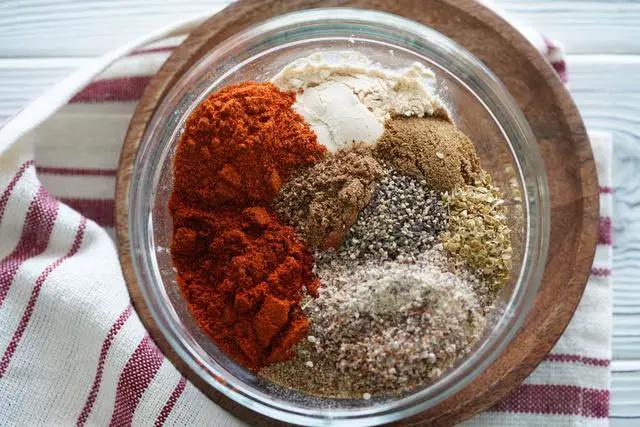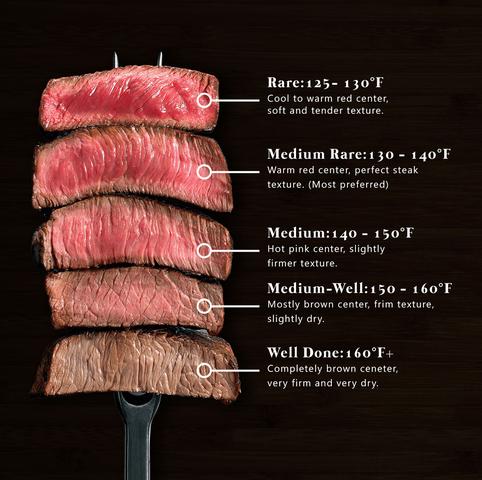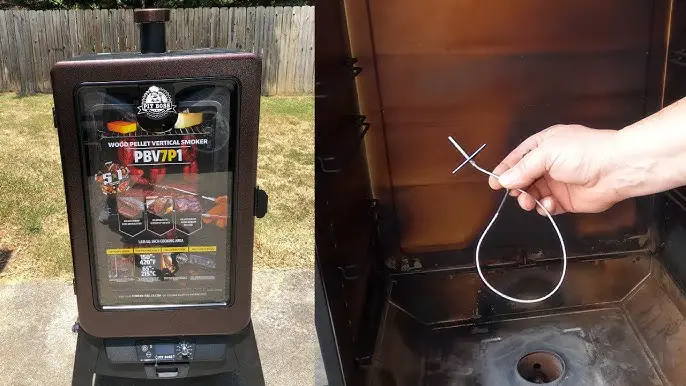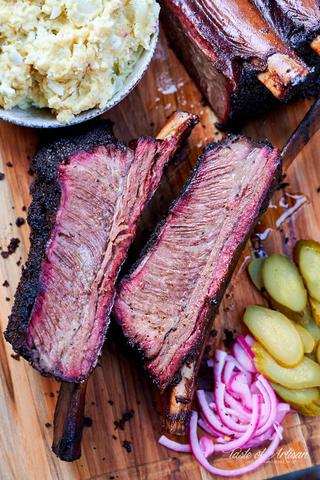
“Indulge in the irresistible flavors of Smoked Beef Short Ribs – tender, succulent, and bursting with smoky goodness. Savor the rich and juicy meat that falls right off the bone, delivering a culinary experience like no other. Elevate your taste buds to new heights with these delectable ribs that promise to satisfy even the most discerning palates. Prepare to be captivated by the mouthwatering aroma and unmatched tenderness of our signature smoked beef short ribs.”
What Are ShortPlate Ribs?
Short plate ribs are a cut of beef that comes from the plate primal of the cow, which is low on the chest and sits behind the brisket primal. These ribs are known for their large size and well-marbled meat, which gives them a rich and beefy flavor. They are often referred to as “dino ribs” due to their incredible size when untrimmed. Short plate ribs usually consist of three to four bones, with each bone having one to two inches of meat on top. While not as readily available as pork ribs, short plate ribs can be sourced from high-quality butchers.
What Do You Need ToSmokeShortPlate Ribs?

To smoke short plate ribs, you will need the following:
- Short plate ribs: These can be difficult to source, but a high-quality butcher may have them available.
- Smoker: Whether it’s an offset smoker, pellet grill, electric or gas smoker, or charcoal grill set up for indirect heat, you’ll need a device that can maintain a consistent temperature and produce thin blue smoke.
- Binder: A binder helps the dry rub adhere to the meat. Yellow mustard is a popular choice, but mayonnaise or oil can also be used.
- Dry rub: Use a basic Texas-style brisket rub consisting of equal parts coarse salt and coarse black pepper. This enhances the beef flavor of the ribs.
- Butcher paper or aluminum foil: Wrapping the ribs during smoking can help them get through the stall and prevent drying out. Aluminum foil is easy to find, but waxless food-grade butcher paper is also suitable.
- Towels and cooler/oven: After smoking, it’s important to let the ribs rest to allow juices to redistribute. However, make sure they don’t drop below 140°F to avoid bacterial growth. You can wrap them in towels and place them in a cooler or preheated oven for proper resting.
How To Prepare ShortPlate RibsForSmoking
Before smoking short plate ribs, it is important to properly trim and season them. Start by trimming any excess fat from the ribs, ensuring that there is no more than ¼ inch of fat remaining. Leave the silver skin membrane intact as it helps hold the meat and bones together during cooking.
Next, apply a thin layer of your preferred binder, such as mustard, to all surfaces of the ribs. This will help the seasoning adhere to the meat. Season the ribs generously with a salt-and-pepper rub, ensuring even coverage on all sides. You can also add garlic powder for additional flavor.
Allow the seasoned ribs to sit for at least 30 minutes or up to a couple of hours before smoking. Meanwhile, preheat your smoker to 250°F and choose oak wood for smoking, which complements the beefy flavor of short plate ribs.
Do I Need ToRemoveThe Silver Skin On The Bottom Of The Ribs?
The silver skin, or membrane, is a thin layer found on the bottom of ribs. While most recipes for pork ribs call for the removal of this membrane, it is recommended to leave it on when smoking short plate ribs. The silver skin helps hold the rib meat and bones together as they cook.
Therefore, there is no need to remove the silver skin on the bottom of the ribs when smoking short plate ribs.
Fire Up YourSmoker
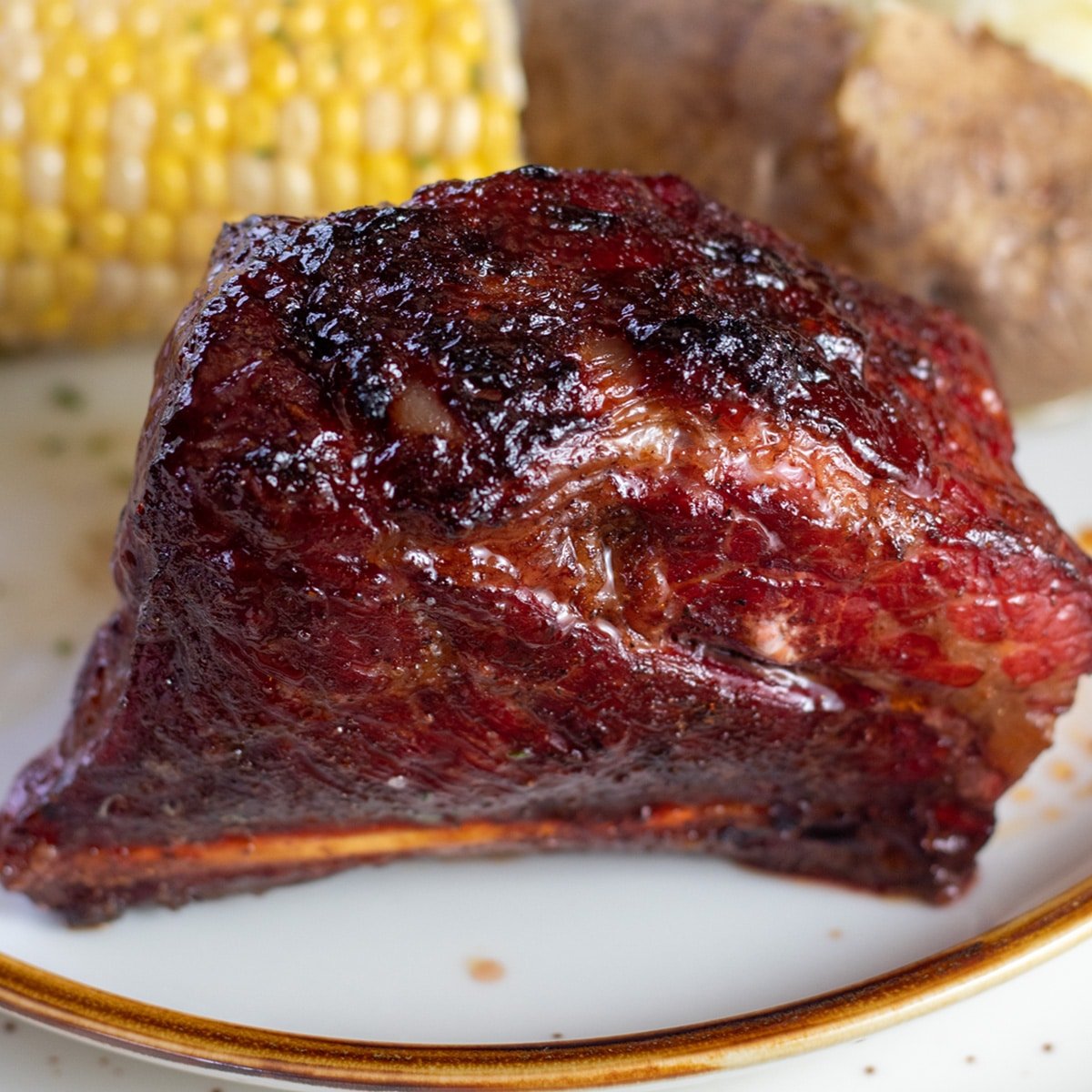
To begin smoking your beef short ribs, you’ll need to fire up your smoker and get it up to temperature. Whether you’re using an offset smoker, pellet grill, electric or propane smoker, or a charcoal grill, aim for a temperature of 250°F. This temperature provides enough heat for proper cooking while allowing for plenty of smoke flavor.
When it comes to choosing the type of wood to use for smoking, oak is recommended due to its similarities with brisket. Oak gives the short plate ribs a quintessential central Texas flavor when combined with salt and pepper. If you’re unsure about which type of wood to use on your electric smoker or charcoal grill, refer to our guide on smoking with wood chips vs wood chunks.
Once your smoker is at the desired temperature, insert a meat thermometer probe into the thickest part of the rib meat. Be sure to avoid any pockets of fat that could throw off your temperature reading. Now your ribs are ready to be placed in the smoker.
The Stall
The stall refers to a period during the smoking process where the internal temperature of the meat plateaus. This happens due to the evaporation of moisture counteracting the heat of the smoker. While it is more commonly associated with larger cuts of meat like brisket and pork butts, short plate ribs can also experience a stall, although it is not as long. The stall typically occurs when the internal temperature reaches anywhere between 150°F-180°F.
During the stall, you have two options. You can choose to wrap your ribs in aluminum foil or unwaxed food-grade butcher paper to help counteract the stall and continue cooking. Wrapping helps retain moisture and speeds up cooking time. Alternatively, you can choose to let the ribs power through the stall without wrapping them. This will result in a longer cooking time but can still yield tender and flavorful ribs.
It’s important to monitor the internal temperature of your ribs during this stage using an instant-read thermometer. Once your ribs reach an internal temperature of around 190°F, you can start testing for tenderness by inserting a probe into the thickest part of the meat. The ribs are done when they feel tender and allow the probe to slide in easily without resistance.
After smoking, whether you wrapped your ribs or not, it’s crucial to let them rest for a minimum of 30 minutes and up to two hours before serving. Resting allows for juices to redistribute within the meat, resulting in a more flavorful and moist final product. Remember not to let your ribs drop below 140°F during resting, as this is within bacteria’s ideal temperature range for growth.
In summary, while short plate ribs may experience a stall during smoking, you have options such as wrapping or letting them power through without wrapping. Monitoring internal temperature and testing for tenderness will guide you towards perfectly smoked and delicious beef short plate ribs. Don’t forget to let them rest before slicing and serving!
What Are The Best Sides ForBeef Ribs?
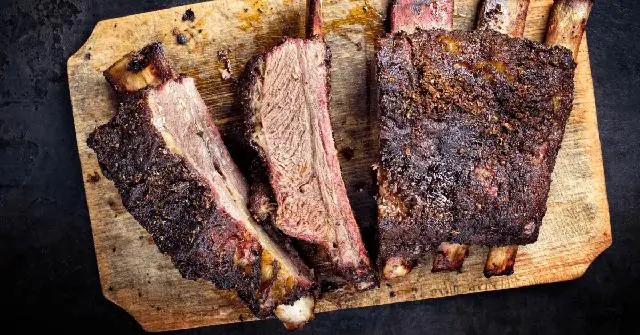
When it comes to serving beef ribs, there are several delicious side dishes that pair well with their rich and flavorful taste. One classic option is mac and cheese, a BBQ staple that adds a creamy and cheesy element to the meal. Another popular choice is corn on the cob, which provides a sweet and crunchy contrast to the meat. Potato salad is also a great side dish option, offering a cool and refreshing accompaniment to the smoky ribs.
If you’re looking for something a bit different, consider serving coleslaw alongside your beef ribs. The crisp and tangy flavors of coleslaw help cut through the richness of the meat, creating a well-balanced meal. Baked beans are another tasty option, providing a savory and hearty addition to your plate.
Ultimately, the best sides for beef ribs will depend on personal preference and the overall flavor profile you’re aiming to achieve. Whether you choose classic BBQ sides or opt for more unique options, these sides will complement the deliciousness of smoked beef short ribs.
SmokedBeefShortRibsRecipe
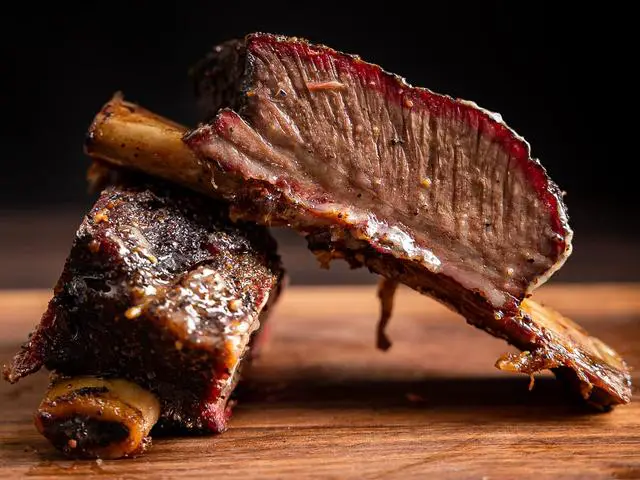
Smoking beef short ribs is a delicious and rewarding experience. The process may take some time, but the end result is well worth it. Here’s a simple recipe to follow:
- Start by trimming the ribs to remove any excess fat. Leave the silver skin on as it helps hold the meat and bones together during cooking.
- Apply a thin layer of mustard as a binder to all surfaces of the meat, then season generously with salt and pepper. You can also add garlic powder for additional flavor.
- Preheat your smoker to 250°F and use oak wood for a classic Texas-style flavor.
- Place the ribs in the smoker, making sure the thickest part of the rack is positioned towards the hotter side if your smoker has uneven heat distribution.
- Let the ribs smoke for about two hours before giving them a spritz with water or apple juice every 30-45 minutes to prevent drying out.
- The internal temperature of the ribs will plateau between 150°-180°F. You can choose to wrap them in aluminum foil or butcher paper at this point to help counteract this stall, or let them power through naturally.
- Once the internal temperature reaches around 190°F, test the tenderness of the meat using an instant-read thermometer. The probe should slide through like room-temperature butter with no resistance.
- If you wrapped your ribs, rest them in a preheated cooler or oven at 150°F for at least 30 minutes to allow juices to redistribute. If not wrapped, wrap them in foil or butcher paper and rest for the same amount of time.
- Slice into individual ribs and serve! These smoked beef short ribs are flavorful enough on their own and don’t require any additional sauces.
Pair these delicious ribs with your favorite side dishes like mac and cheese, corn on the cob, or potato salad for a complete BBQ meal.
Smoked Beef Short Ribs Recipe
Short plate ribs, also known as dino ribs, are a delicious and flavorful cut of beef that can be smoked to perfection. Here is a simple recipe to follow:
1. Start by trimming the excess fat from the ribs. Make sure the layer of fat is not too thick to render properly.
2. Leave the silver skin on the ribs as it helps hold the meat and bones together during cooking.
3. Apply a thin layer of mustard as a binder to all surfaces of the meat, then season well with a salt-and-pepper rub. You can also add garlic powder for extra flavor.
4. Let the rub sit on the ribs for half an hour or longer if desired.
5. Preheat your smoker to 250°F and use oak wood for smoking to enhance the beef flavor.
6. Place the ribs in the smoker and let them smoke for about two hours before giving them a spritz with water or apple juice to prevent drying out.
7. Continue smoking the ribs, spritzing every 30-45 minutes, until they reach an internal temperature of around 190°F.
8. Test the tenderness of the meat using an instant-read thermometer by inserting it into the thickest part of the rib without touching any fat pockets.
9. Once done, wrap the ribs in foil or butcher paper and let them rest for at least 30 minutes up to two hours at a temperature above 140°F but below 150°F.
10. Slice into individual ribs and serve as is, without any barbecue sauce or additional seasoning, allowing the natural flavors of the smoked beef to shine through.
You can serve these smoked beef short ribs with your favorite sides such as mac and cheese, corn on the cob, or potato salad for a complete BBQ meal.
Equipment
To smoke beef short ribs, you will need the following equipment:
- A smoker – This can be an offset smoker, a pellet grill, electric or gas smoker, or even a charcoal grill set up for indirect heat as long as you can maintain a consistent temperature and produce thin blue smoke.
- Binder – A common binder used is yellow mustard, but you can also use mayonnaise or oil.
- Dry rub – Stick with a basic Texas-style brisket rub, which consists of equal parts coarse salt and coarse black pepper.
- Butcher paper or aluminum foil – Wrapping your ribs in either butcher paper or aluminum foil is optional but can help get the meat through the stall and prevent it from drying out. Waxless food-grade butcher paper is a great option if available.
- Towels and cooler/oven – After smoking, it’s important to let the ribs rest to allow the juices to redistribute. To do this, wrap them in towels and place them in a cooler or preheated oven set to 150°F. Avoid letting the temperature drop below 140°F to prevent bacteria growth.
Ingredients
– Short plate ribs
– Yellow mustard (binder)
– Coarse salt and coarse black pepper (dry rub)
– Aluminum foil or waxless food-grade butcher paper (optional for wrapping)
– Towels and cooler/oven for resting
Instructions
1. Begin by trimming the excess fat from the short plate ribs. If there is a layer of fat thicker than ¼ inch, trim it down using a sharp knife.
2. Leave the silver skin on the ribs, as it will help hold the meat and bones together during cooking.
3. Apply a thin layer of mustard or your preferred binder to all surfaces of the meat, then season well with a salt-and-pepper rub. You can also add garlic powder for extra flavor.
4. Let the rub sit on the ribs for at least 30 minutes or up to a couple of hours.
5. Preheat your smoker to 250°F and use oak wood for smoking, as it pairs well with beef.
6. Insert a meat thermometer probe into the thickest part of the rib meat, avoiding any pockets of fat.
7. Place the ribs in the smoker and let them smoke for about two hours before opening the lid again.
8. Every 30-45 minutes, spritz the ribs with water or apple juice to prevent drying out and enhance smoky flavors.
9. The stall may occur between 150°-180°F internal temperature. You can choose to wrap your ribs in aluminum foil or butcher paper to counteract this or let them power through without wrapping.
10. Once the internal temperature reaches around 190°F, test the tenderness of the meat by inserting an instant-read thermometer into the thickest part. The probe should slide through easily without resistance.
11. Rest your cooked ribs for at least 30 minutes up to two hours, ensuring they stay above 140°F to avoid bacterial growth.
12. Slice the ribs into individual pieces and serve as they are, without any barbecue sauce. The beefy flavor of the ribs will be delicious on its own.
13. Pair your smoked short ribs with your favorite barbecue sides, such as mac and cheese, corn on the cob, or potato salad.
Remember to experiment and adjust the cooking process to your preferences and equipment. Enjoy your smoked beef short ribs!
Nutrition
Unfortunately, the topic information does not provide any specific information about the nutrition of smoked beef short ribs. However, it is important to note that beef ribs, in general, are a rich source of protein and essential nutrients such as iron, zinc, and B vitamins. The exact nutritional content may vary depending on factors such as the cut of meat and cooking method.
FAQs:
-
- Do I need to remove the silver skin on the bottom of the ribs?
No, you do not need to remove the silver skin on these short plate ribs. It helps hold the meat and bones together as it cooks.
-
- Should I use barbecue sauce with my smoked beef short ribs?
No, these short plate ribs do not need any sauces, BBQ sauce or otherwise, to be enjoyed. Serve them as they come off the smoker for plenty of flavor.
-
- What is the best wood to use when smoking these ribs?
We recommend using oak wood for smoking these short plate ribs. It provides a quintessential central Texas flavor that pairs well with salt and pepper.
-
- How long should I smoke these ribs for?
Smoke the short plate ribs for about 2 hours before giving them a spritz and continuing to smoke until they reach an internal temperature of around 190°F.
-
- Do I need to wrap the ribs during smoking?
You can choose to wrap the ribs in aluminum foil or unwaxed food-grade butcher paper to help counteract any stall that may occur. However, if you prefer not wrapping, you can skip this step.
-
- How long should I let the ribs rest after smoking?
Let the smoked ribs rest for a minimum of 30 minutes and up to two hours. Make sure they don’t drop below 140°F during this time to prevent bacteria production.
Question: Should I UseBarbecue SauceWith MySmoked Beef Short Ribs?
Question: Should I Use Barbecue Sauce With My Smoked Beef Short Ribs?
When it comes to smoked beef short ribs, there is no need to use barbecue sauce. These ribs are packed with flavor and are best enjoyed as they come off the smoker. The meat is well-marbled and has plenty of beef flavor, so you don’t need any additional sauces to enhance the taste. Simply season the ribs with a salt-and-pepper rub or add some garlic powder for extra flavor, then let them smoke until they reach the desired tenderness. Once cooked, slice them into individual ribs and serve them as is for a delicious and flavorful meal.
Using barbecue sauce can sometimes overpower the natural flavors of the beef and mask the smokiness that comes from the smoking process. So, it’s best to let these smoked beef short ribs shine on their own without any additional sauces. Pair them with your favorite side dishes like mac and cheese, corn on the cob, or potato salad for a complete BBQ meal. Enjoy the rich and savory taste of these incredible smoked beef short ribs without any added sauces for a truly satisfying dining experience.
In conclusion, smoked beef short ribs are a delectable and flavorful dish that can be enjoyed by meat lovers. The slow smoking process enhances the tenderness and infuses a rich smoky flavor into the meat. Whether served as a main course or at a barbecue, these ribs are sure to satisfy any carnivorous craving.
Learn More About Grilling
If you want to learn more about grilling, check out these other helpful resources!

